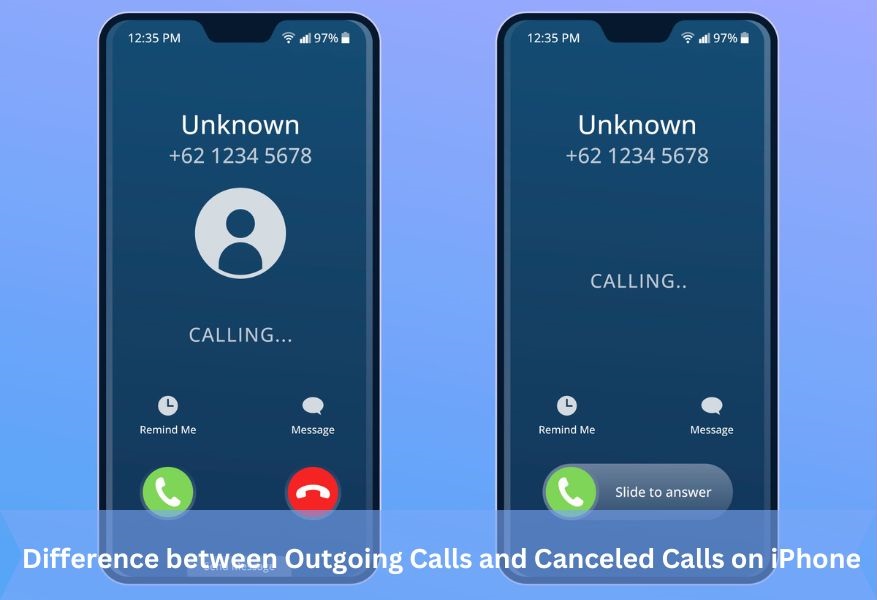Difference between Outgoing Calls and Canceled Calls on iPhone

Contents [Show]
Smartphones, which provide a wide range of characteristics and functions, have become an essential part of our lives in the current digital era. Making and receiving calls continues to be a vital element among these functionalities. But If you are an iPhone user, you've likely made many calls and noticed different statuses for those calls. Two terms that often create confusion are "Outgoing Call" and "Canceled Call." Though they may seem similar, they are not the same. We'll examine the distinctions between these two call kinds on your iPhone in this article and explain why they're important.
What is an Outgoing Call?
An outgoing call on an iPhone refers to any call that you initiate. When you dial a number or tap on a contact to call, the call is labeled as "outgoing" in your call log. It means you are the one who started the communication.
Features of Outgoing Calls
- Initiation:
Initiation describes the process of starting a call to a specified number or contact when discussing outgoing calls on your iPhone. A call is started by choosing the contact or recipient's number from your contact list and pressing the call button. When you take this step, your iPhone connects to the target recipient and places the call.
- Charges:
You may incur charges based on your phone plan. Charges often refer to the associated expenses involved while placing outgoing calls on your iPhone.
- Call Log:
Appears in your call log as an 'outgoing' call. The standard call log on your iPhone, often known as the "Call History," maintains track of all your incoming, outgoing, and missed calls.
What is a Canceled Call?
A canceled call, on the other hand, refers to a call that was initiated but not connected. This could be because you decided to end the call before the other party picked up or the call failed to connect for some reason.
Features of Canceled Calls Initiation
- Initiation:
You initiated the call but ended it before a connection was made.
- Charges:
Generally, no charges are applied as the call is not received or is hung up before being received.
- Call Log: Appears as 'canceled' in your call log.
Key Differences
User Intent
Outgoing Call: When making an outgoing call, the user wants to connect with the recipient for a particular reason. This objective might take many different forms, from informal interactions with friends and family to more official or professional conversations. You want to talk and are waiting for the other person to answer.
Canceled Call: For canceled calls, the user's aim is different. The user plans to make a call by choosing a contact or dialing a number when a call is canceled. However, you either change your mind or face an issue, leading to the call's termination before it starts.
Network Connection
Outgoing Call: The call attempts to connect to the other party. An iPhone actively makes a connection with the recipient's cell phone or contact during an outbound call. The call attempts to connect to the other party. This connection makes use of your cellular network or, if Wi-Fi Calling is turned on, a Wi-Fi connection if one is available. The iPhone keeps its network connection throughout the call, enabling two-way communication.
Canceled Call: The network connection varies when a call is canceled. The network involvement is minimal if you start a call and opt to end it once it connects or is received. When the user decides to discontinue the call, the iPhone delivers a signal to create the link, but it is soon broken.
Call Log Status
Outgoing Call: Appears as 'outgoing' in your call log.
Canceled Call: Appears as 'canceled' in your call log.
Why the Difference Matters
Understanding the difference between these two terms can help you manage your call logs and phone bills better. Knowing what each term means can save you from unexpected charges and help you keep a clear record of the Conclusion of your calls.
Financial Implications
Outgoing Calls
Cost Factor: Outgoing calls often incur charges based on the duration of the call.
International Charges: If you're calling someone in a different country, the cost could be significantly higher.
Canceled Calls
No Charges: In most cases, canceled calls do not lead to any charges.
Exception: Some carriers might charge a minimal fee for call attempts, but this is rare.
Emotional Aspects
Outgoing Calls
Anticipation: When you make an outgoing call, there's a level of expectation for the conversation.
Closure: The call usually concludes with an understanding or resolution.
Canceled Calls
Uncertainty: Canceled calls often leave a sense of unfinished business or lack of closure.
Frustration: They can be frustrating, especially if the cancellation was due to poor connectivity.
Technology Behind Calls
Outgoing Calls
Network Use: Outgoing calls use more of the network's resources as they establish a two-way communication channel.
Data Usage: If you're using VoIP services like WhatsApp or Skype, outgoing calls will consume data.
Canceled Calls
Minimal Network Use: Canceled calls use fewer network resources as they are terminated quickly.
No Data Usage: They usually do not consume any data unless a connection was initially made.
Practical Tips for Managing Calls
Outgoing Calls
Plan Ahead: Make sure you're aware of any costs associated with the call.
Time it Right: Consider the time zone of the person you're calling.
Canceled Calls
Quick Action: If you need to cancel a call, do it quickly to avoid possible charges.
Check Carrier Policies: Understand your carrier's rules around call cancellations to avoid surprises.
User Experience and Interface
Outgoing Calls
Interactive: Outgoing calls provide more interaction, with options like merging calls or adding others to a conversation.
Feedback: Features like call waiting tones and time counters offer a guided experience.
Canceled Calls
Brief: User interaction is minimal, often reduced to just dialing and then ending the call.
Lack of Feedback: Since the call doesn't connect, there are no additional features or guidance provided.
Troubleshooting and Support Outgoing Calls
Outgoing Calls
Technical Support: If an outgoing call fails, the user often has a range of troubleshooting options, from checking the network to contacting customer support.
Software Features: Built-in diagnostics can sometimes identify why a call didn't connect.
Canceled Calls
Limited Options: With canceled calls, troubleshooting is often not applicable, as the user typically ends the call intentionally.
No Support: Customer support is generally not involved because the call was not connected to begin with.
Privacy Concerns
Outgoing Calls
Data Sharing: Outgoing calls often mean both parties exchange information, which could be a concern if you're privacy-oriented.
Call Recording: There is a potential for the other party to record the conversation.
Canceled Calls
Minimal Data: Since the call never connects, less data is exchanged between both parties.
No Recording: The call can't be recorded if it was never connected, offering a layer of privacy
Conclusion
Though they might seem somewhat similar, outgoing and canceled calls on an iPhone have key differences that every user should know. An outgoing call is one that you initiate and try to connect, while a canceled call is a call that you end before a connection is made. Understanding these differences is crucial for effective communication and efficient use of your iPhone.


0 Comments